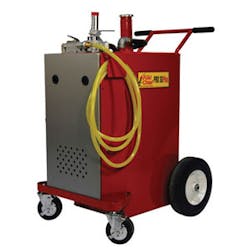With decreasing auto sales and higher fuel costs, shops are relying on preventative maintenance for extra income when servicing customers’ vehicles.
Fluid exchange systems, including transmission and coolant exchangers, as well as brake fluid and fuel system flush machines, allow shops an opportunity to increase revenue and earn a higher return on investment for the capital equipment they purchase.
When it comes to this equipment, many companies offer machines with the ability to clean out systems in order to extend the life of a vehicle, and keep them running smoothly.
FEWER PARTS AND FASTER SERVICE
Shops look at efficiency and the time it takes to use fluid exchange systems, to earn a higher return on their equipment. When trying to save time, shops often look for fewer parts, pieces or steps.
One example includes Symtech’s ATF1 Transmission Flusher, which allows techs to complete the flush directly through the vehicles’ dipstick, without additional adaptors.
“There’s a tube that goes right down through the dipstick, and it will do the exchange that way. It’s a much easier process,” said Gary Hutchison, vice president of sales and marketing for Symtech Corp. “(Techs) don’t have to climb under cars looking for the cooler lines, wondering if they have the right adaptors. It eliminates all of that.”
Along with easier usage, manufacturers continue to combine the service on multiple machines into one.
“You can perform the service by going in the in-line pressure, or you can perform the service just going through the dipstick. You can actually have two service capabilities in one machine,” said Hutchison.
Along with combining more than one service on a particular machine, manufacturers have developed ways to make flush-and-fill systems run more quickly, and with less labor. MotorVac’s MBV 8100 works with both air pressure and vacuum-style brake bleeding.
“This system can complete a full brake system flush in 10 minutes,” said Geoff Preston, MotorVac’s marketing manager. “The one-man operation ensures maximum profitability for the shop by allowing other technicians to service other vehicles.”
After the initial unit is sold, shops will still continue to need and request chemicals, adaptors and upgrades for their current flushing systems.
Clore plans to introduce accessories that will make transmission flushes faster than before.
“We’re in the development of a quick-connect fitting program, so that all the fittings would quick-connect to our service hoses, so there would be no manual sort of connection made,” said Jim O’Hara, Clore’s director of marketing.
Some companies have developed equipment that doesn’t require branded chemicals exclusive to their equipment in order to perform the job, such as RTI Technologies.
“We have no allegiance to fluids. We’re completely compatible with the full range of chemicals that are being used out there in the market today. We’re just equipment people,” said Kelvin Butz, RTI’s vice president of marketing.
ECONOMIC TRENDS AND FUEL EFFICIENCY
“Since the cost of fuel has risen, the interest in fuel system cleaning services has greatly increased,” said MotorVac’s Preston. “Fluid maintenance services will continue to grow as new car sales decrease and consumers realize they must keep their vehicles operating longer and with fewer repairs.”Alternatives to gasoline engines have prompted RTI Technologies to follow the changing trends of vehicle fueling by developing a diesel cleaning system.
“Because of the price of fuel going up, the resurgence in diesel-engine-powered vehicles — passenger cars and light pickup trucks — is starting to see a real pickup in demand for those types of products,” said Butz.
“It’s all related to keeping your vehicle in prime operating condition … keeping those fluids fresh, and in top operating condition is important for fuel economy.”
As consumers continue to keep the same vehicles longer, and find ways to increase fuel efficiency, they turn to local auto shops in order to keep their cars running as long as possible.
“The shop benefits because fluid maintenance services will add new sales to offset the diminishing number of repairs. When using a machine, these services can be performed fast, efficiently and safely, and chemical solutions can deliver greater value to the customer,” said Preston.
WATCH FOR WHAT THEY NEED
“If they’re selling to the end user, the professional doesn’t care what the cost of something is, if he recognizes the value of the benefits,” said Hutchison. “What’s important to the tech is availability, service, quality and value. Price is way down the list.”
Along with profitability based on selling the initial unit, margins increase with the added accessories and equipment that can periodically be updated for each system.
“The machine puts the shop in the fluid maintenance business while the service chemicals can help provide a steady revenue stream and enhance profit margins,” said Preston.
It’s also important to assess the shops needs.
Do they specialize in fluid exchange? Are they looking for a machine that offers quick and consistent use or equipment that performs longer, thorough flushes? Regardless of what equipment the shop provides, it’s important to realize that general maintenance is a concern for both the end user and the shop.
“When a shop performs (preventative maintenance) services, the customer willingly brings their vehicle into the shop and is prepared to pay for service. These vehicles do not stay overnight and will go in and out of the shop in the same day,” said Preston. “The consumer will benefit by reducing cost, saving time and avoiding potential repairs.”
This relationship not only extends from customer to shop, but from shop to the mobile dealer, too.
“(Mobile distributors are) making themselves the expert in the category, and by being the expert in the category, that shop is going to turn to them more to purchase that capital equipment,” said O’Hara. “They’re a sounding board. Less of a salesman and more of a consultant.”


